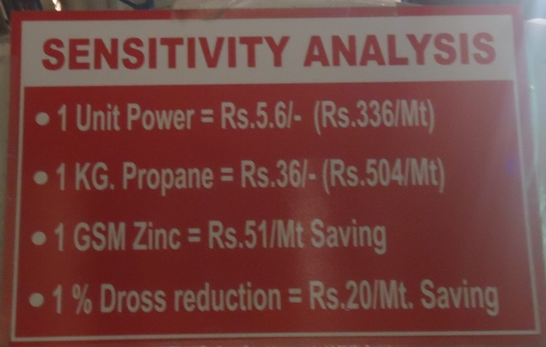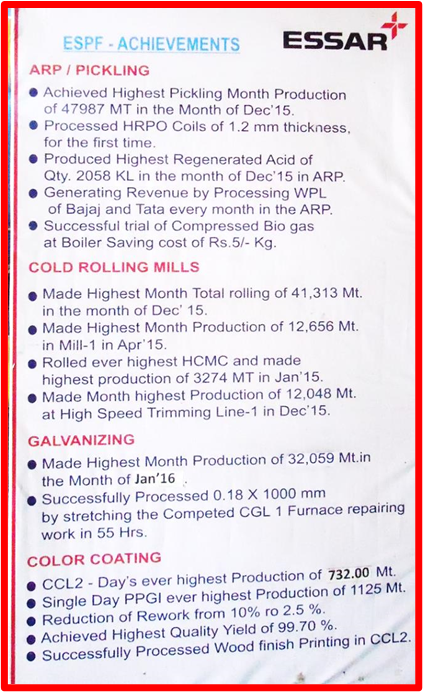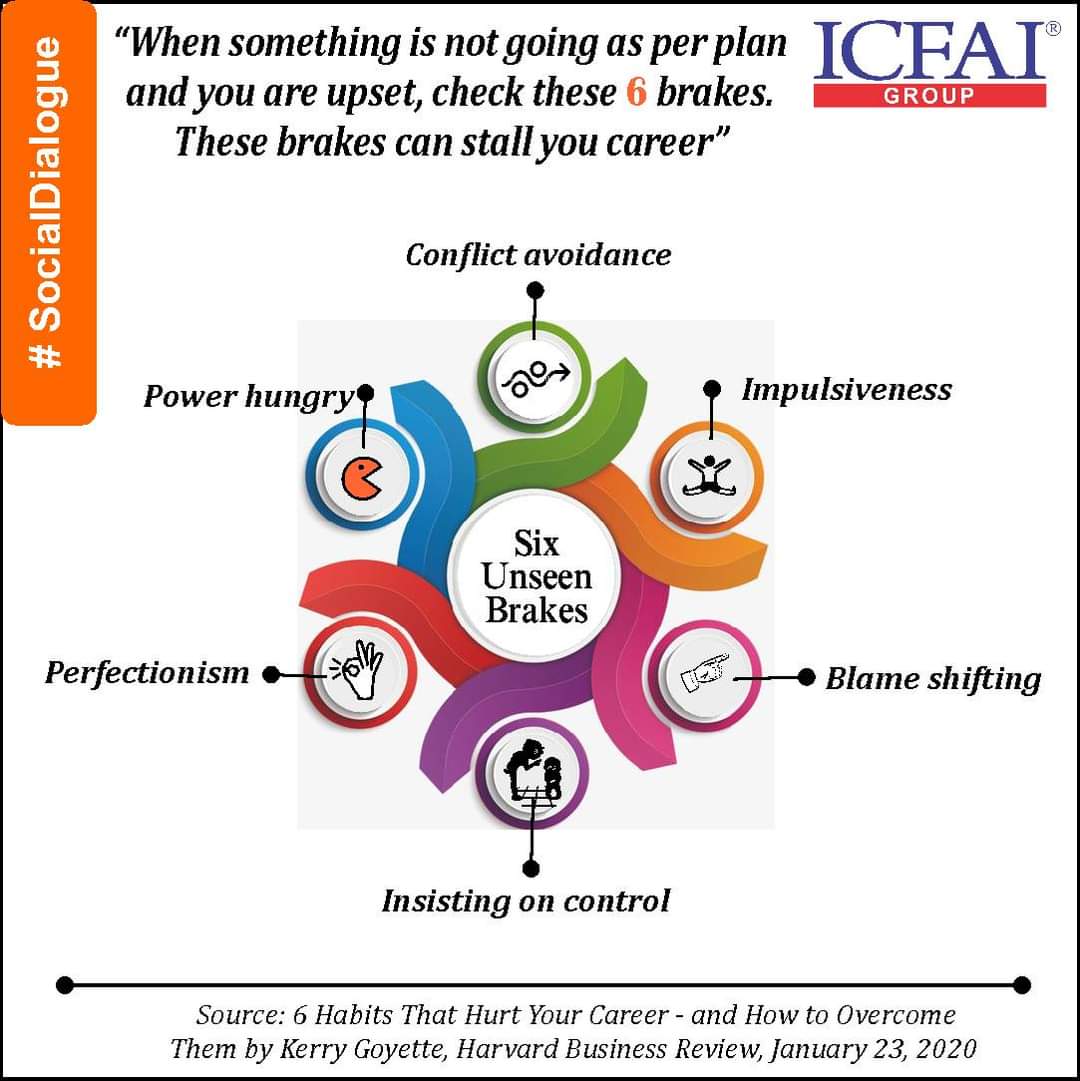
On Friday, November 18, we had an engaging session by Mr R V Sridhar, a senior executive of Arcelor Mittal and an experienced steel industry professional. Mr Sridhar spoke about what goes into corporate turnarounds, an area in which he is an expert and has considerable experience. The session was moderated by Prof R Prasad and Prof Sudhakar Rao.
About Mr. RV Sridhar
Mr. RV Sridhar is Executive Director - Downstream at ArcelorMittal Nippon Steel India Limited (AM/NS India). He manages one of AM/NS India’s significant business units with an annual turnover of Rs. 23,000 crores spanning 5 million tonnes of steel, and another 2 million tonnes upcoming, with operations spread across two countries.
In his earlier assignment, as ED & CEO of Essar Steel Precoated Facility, he turned around the business from being a loss maker to one of Essar Steel’s most profitable SBUs through process innovation and improved working capital management. He achieved a consistent >97% plant utilization level, the highest customer satisfaction index, and an enviable employee engagement index of 84%. He was also responsible for turning around the company’s Indonesia business.
Earlier, Mr. Sridhar was the Global Business Head of Essar’s Rs. 7000 Cr Downstream & Auto Division, one of India’s largest downstream businesses. Mr Sridhar has also worked for 4 years with the East African steel major MRM Ltd.
With more than 30 years in the steel industry covering both public/private sectors, Mr. Sridhar has travelled to over 80 countries and has presented papers at many steel conferences with critical acclaim. Thanks to his extensive WTO/Anti-dumping/Anti-subsidy experience, he was the sole private sector representative for Kenya in WTO’s 5th Ministerial Conference at Mexico. Mr. Sridhar has been conferred the Steel CEO of the Year 2017 award by the Steel Users Federation of India.
Mr Sridhar has also worked with the International Trading Division at Tata Steel & SAIL. He re-engineered Tata Steel outbound logistics models, achieving significant cost reduction. He has spearheaded 8 QIPs in Tata Steel.
Mr. Sridhar holds a Master’s degree in International Business from IIFT, New Delhi and a Post-graduate degree in Quantum Electronics, Fibre Optics & Communications.
The Indian steel industry
India has one of the lowest per capita steel consumption figures in the world. But there are exciting opportunities to grow the market. Steel is a recyclable and versatile material that is used in different applications in our country: automobiles, rail, highways, low cost housing, public (Swachh Bharat) toilets, solar plants, etc. Currently the steel consumption is about 140 million Mt. The government wants to increase it to 300 mn MT by 2030. India is the second largest consumer of steel in the world though we are far behind China. Steel makes up about 4% of our GDP.
About AM/NS India
AM/NS, a joint venture between ArcelorMittal (the largest steel manufacturer in the world) and Nippon Steel (the third largest steel manufacturer in the world) is an integrated steel manufacturer, which converts iron ore to ready-to-market products. The company has a capacity of 9 million tons per annum (MTPA) and produces 300 grades of steel. The manufacturing facilities comprise iron making, steelmaking and downstream facilities spread across India. The company is exporting steel to 110 countries (and still counting)!
Process innovation
Removal of unnecessary steps.
Processes can often be improved by eliminating unnecessary steps. A good example is the carburetor. Why should we mix the oil and air in a separate process step? Why not have a direct fuel injection engine?
In color coated roofs, AM/NS has a market share of 60%. On the steel substrate a primer is applied and then a final coat of paint. The role of the primer is to adhere firmly to the substrate. But when we use primer and enamel, we need to bake and cure both of them in two separate ovens. By eliminating the primer and having an all in one paint, we can eliminate the primer costs and more importantly manage with one oven less, resulting in a significant reduction in power costs. This was the technique Mr. Sridhar pioneered in Essar to bring down the cost of steel by Rs 3000/ton. About 20% of the cost savings were due to materials and the remaining 80% due to the power saved.
Cost disruption
A good example is Huawei. It came up with cheap sensors for narrow band IOT.
Crowdsourcing of ideas
It is important to listen to stakeholders to get good ideas. A good example is Lego. By listening to customers, the company was able to come up with innovative products. Every Saturday, in an initiative called Coffee with the CEO, Mr. Sridhar keeps his doors open and listens carefully to employees at all levels.
The innovator’s dilemma
We should be prepared to disrupt our business model when something cheaper, simpler and more customer friendly emerges. That is the basic principle of Prof Clayton Christensen’s Innovators’ Dilemma. Kodak was not prepared to embrace digital whereas Fuji was. Microsoft sensed the PC opportunity, but IBM wanted to cling to mainframes. Blockbuster, carried away by its success, continued to charge late fees from customers for returning videos late. Netflix in contrast allowed customers to keep their videos for as long as they wanted to. Mini mills like Nucor which used scrap as the raw material in their electric arc furnaces, disrupted the integrated steel manufacturers who fed iron ore and coke into their blast furnaces.
Lessons from Deng Xiaoping
What explains China’s success under Deng Xiaoping? The Chinese leader believed in seeking truth from the facts. He also realized that while crossing the river, it is important to feel the stepping stones. So before embarking on something new, it is important to test the waters. Deng was also a benevolent leader and put people’s livelihood ahead of everything else. In short, a leader’s intent and the signals she sends can make a big difference in any corporate turnaround.
Lessons from Sam Walton
Walmart founder, Sam Walton had two mantras: Cost reduction and high expectations.
Lessons from Steve Jobs
Jobs believed in the concept of the Reality Distortion Field. He encouraged his employees to put themselves on a higher plane and believe that even impossible things were possible.
Lessons from Volvo
It is important to eliminate waste and superfluity. Volvo v8 has a feature called Dynamic cylinder deactivation. When not required, the cylinders are deactivated, improving efficiency, and reducing costs.
Lessons from 3G Capital
It is important to have high ambitions and set stiff targets to achieve outstanding outcomes. In this context, we have a lot to learn from private equity firms which invest in struggling firms and then turn them around.
The private equity firm 3G capital operates very differently from the staid FMCG companies such as Nestle and Unilever. 3G believes in sweating assets and improving efficiency. It has a reputation for taking over distressed assets, revitalizing them and then finding a seller.
It was by sweating assets that Mr Sridhar turned around Essar and took it from a revenue of Rs 1400 crores to Rs 5000 crores and EBIDTA from Rs 10 crores per month to Rs 50 crores per month.
Nestle |
3G Capital |
• Laid Back / Staid Culture |
• Proactive Culture |
• Belief in Incrementalism |
• Belief in Radical Changes |
• Tinkerer Mentality |
• Emphasis on Cost reduction |
• Operational profit of 15% |
• Operational profit of 27% |
Lessons from Zappos
The right culture also matters in accelerating process innovations. Zappos believes in holacracy, i.e. a flat, decentralized structure with a high degree of employee empowerment and quick decision making. At Zappos, orders are processed in 8 minutes. Customers are so delighted that Zappos receives many endorsements and recommendations from them.
Lessons from Google and Virgin
Google and Virgin are other examples of companies with a positive work environment and a high degree of employee engagement. Google’s motto is to deliver happiness to customers.
Communication
It is important to have simple and transparent communication with employees. They should be familiar with sensitivity analysis, i.e. how costs behave for different materials. AM/NS uses boards in different languages to convey both targets set for different departments and their achievements. (See boards below.)


Empathy and toughness
Lord Siva is often called Ardhanareeswara, i.e. a combination of the male and the female. The female side represents empathy and concern. The male side represents discipline, and no compromise on core values such as integrity. In other words, great leaders have the right blend of task and people orientation.
Exploring new markets
Mr Sridhar keeps reminding his team about the importance of growing the rural markets, where there are big opportunities. The mantra he follows is to go beyond making more steel to offering various other services that improve customer experience. Accelerated product development is a part of this plan. The company is tapping new segments/applications such as heat reflecting roofs, self-cleaning roofs, specialty auto steel tubes, heavy (49 ton) trucks of Volvo, submarines, bullet trains running from Bombay to Ahmedabad and various iconic buildings.
Exploiting institutional voids
The Tatas saw that between 400-500 kg autos and 16 ton trucks, there were no other vehicles. This gave them the idea of launching 1,2,3 tons Ace trucks. These trucks revolutionized transportation. Similarly for AM/NS, between galvanised steel and colour coated steel, there is scope to launch new products.
Tapping Blue oceans
Mr Sridhar’s philosophy is to avoid contested markets and focus more on uncontested markets. In international markets, China is a tough competitor. Competing with the Chinese head on is a loss making proposition. So, AM/NS has entered Argentina and Bolivia as the Chinese do not export to these countries.
integrity. In other words, great leaders have the right blend of task and people orientation.
Q&A
More about corporate turnarounds
It is always important to anticipate and preempt change. We should not delay actions till change becomes inevitable. We must proactively focus on improving processes and increasing customer delight.
Turnarounds are not only about process innovations and cost cutting. They are also about moving into unexplored and uncontested markets and increasing employee engagement. As already mentioned, Mr Sridhar spends time with his employees at all ranks each Saturday. Employees become motivated and engaged when they feel they are being heard and their views valued. We should remember that employees are not working just for money. They are also looking for fulfilment, and satisfaction.
The behaviours of people must be aligned with the culture of the organization. Articulation of core values and desired behaviours, reward and recognition for the right behaviours including certificates of praise, gift vouchers and showcasing of accomplishments can help in this regard.
On leadership
It is important to listen to people and consult them. But there can only be one leader and he has to make the decision. The experiment of having two Co CEOs at Wipro did not quite work out. (Citicorp tried something similar in the early 2000s. That also failed.)
Sometimes, a peer may become the leader of a team. This is an organizational decision and should be respected. Insubordination will not help. At the same time the leader should stay grounded and take people along.
The leader’s job is to lead from the front and push from behind. The leader should support and defend the team in public and scrutinise and take them to task in private.
During a major incident in one of Arcelor’s important plants located in Pune, there was danger to the lives of employees. Ladies and young people were evacuated first. The management team led by Mr Sridhar was the last to leave.
Leaders should combine task and people orientation. They must demonstrate androgynous leadership.
On leadership in educational institutions
Educational institutions are the spring of ideas. Leaders must be knowledgeable, eager to learn, eager to experiment and bring fresh thinking. Students tend to have good ideas and we must give them opportunities to try out new things.
On rural banking
Credit is a big concern in India. A large part of China’s success can be attributed to the micro credit provided by Alibaba and Tencent to merchants and small businesses. We must revolutionise microfinance. There are big opportunities for rural banking in our country.
On Climate change initiatives
AM/NS has given a big thrust to the use of hydrogen. The Kapoli plant (New Mumbai) uses a process based on electrolysis for producing hydrogen. The electrolysis is facilitated by solar panels. Earlier, hydrogen was generated by cracking ammonia.
Water taken to a great height can generate power. AM/NS uses this technique called Pumped up storage for generating power.
AM/NS also uses regenerative thermal oxidation. Flue gases carry pollutants and a lot of heat. The idea is to convert the flue gas emissions into CO2 and H2O and recycle the heat before releasing them to the atmosphere. The process reduces pollution and conserves energy leading to less consumption of propane and compressed natural gas.
AM/NS consumes a lot of acid. This is recirculated and regenerated to the extent possible.
AM/NS wants to decarbonize its operations by 2030 compared to the national target of 2070.
On grooming and leadership development
AM/NS uses a high potential high performance grid. People in the top right quadrant are put on the fast track. All efforts are made to take care of them. They are provided feedback and steps taken to meet their aspirations.
On why India is finding it difficult to catch up with China
In China, there is freedom and businesses can move with speed. In India, speed is a casualty. China also provides huge subsidies to industries such as semiconductors. India has a lot of catching up to do but at least PM Modi has articulated a vision and some targets such as a $5 tn economy.
